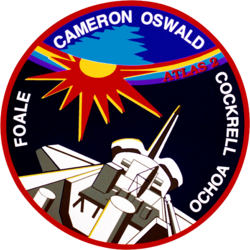Kenneth D. Cockrell
| Kenneth Dale "Taco" Cockrell | |
 | |
| NASA-Astronaut | |
|---|---|
| Född | 9 maj 1950 Austin, Texas |
| Tid i rymden | 64 dagar, 12 timmar, 24 minuter |
| Urvalsgrupp | Astronautgrupp 13 |
| Uppdrag | STS‑56, STS‑69, STS‑80, STS‑98, STS‑111 |
| Uppdragsemblem | |
Kenneth D. Cockrell, född 9 april 1950 i Austin, Texas, är en amerikansk astronaut uttagen i astronautgrupp 13 den 17 januari 1990.
Asteroiden 14917 Taco är uppkallad efter honom.[1]
Rymdfärder
Cockrell var befälhavare ombord på Atlantis/STS-98. Uppdraget var att föra upp och montera fast modulen Destiny Laboratory Module till den internationella rymdstationen ISS.
Källor
”Biographical Data” (på engelska) (PDF). NASA. januari 2018. https://www.nasa.gov/wp-content/uploads/2016/01/cockrell_kenneth.pdf?emrc=e7c347. Läst 5 maj 2024.
- ^ ”Minor Planet Center 14917 Taco” (på engelska). Minor Planet Center. https://www.minorplanetcenter.net/db_search/show_object?object_id=14917. Läst 30 augusti 2024.
Media som används på denna webbplats
STS111-S-001 --- The STS-111 patch symbolizes the hardware, people, and partner nations that contribute to the flight. The Space Shuttle rises on the plume of the Astronaut Office symbol, carrying the Canadian Mobile Base System (MBS) for installation while docked to the International Space Station (ISS). The mission is named UF-2 for ISS Utilization Flight number two. The ISS orbit completes the Astronaut Office symbol and is colored red, white, and blue to represent the flags of the United States, Russia, France, and Costa Rica. The Earth background shows Italy, which contributes the Multi Purpose Logistics Module (MPLM) used on this flight to re-supply ISS. The ten stars in the sky represent the ten astronauts and cosmonauts on orbit during the flight, and the star at the top of the patch represents the Johnson Space Center, in the state of Texas, from which the flight is managed. The names of the STS-111 crew border the upper part of the patch, and the Expedition Five (going up) and Expedition Four (coming down) crews’ names form the bottom of the patch. The NASA insignia design for Shuttle flights is reserved for use by the astronauts and for other official use as the NASA Administrator may authorize. Public availability has been approved only in the forms of illustrations by the various news media. When and if there is any change in this policy, which is not anticipated, the change will be publicly announced.
This mission patch for mission STS-80 depicts the Space Shuttle Columbia and the two research satellites its crew deployed into the blue field of space. The uppermost satellite is the Orbiting Retrievable Far and Extreme Ultraviolet Spectrograph-Shuttle Pallet Satellite (ORFEUS-SPAS), a telescope aimed at unraveling the life cycles of stars and understanding the gases that drift between them. The lower satellite is the Wake Shield Facility (WSF), flying for the third time. It will use the vacuum of space to create advanced semiconductors for the nation's electronics industry. ORFEUS and WSF are joined by the symbol of the Astronaut Corps, representing the human contribution to scientific progress in space. The two bright blue stars represent the mission's Extravehicular Activities (EVA), final rehearsals for techniques and tools to be used in assembly of the International Space Station (ISS). Surrounding Columbia is a constellation of 16 stars, one for each day of the mission, representing the stellar talents of the ground and flight teams that share the goal of expanding knowledge through a permanent human presence in space.
STS-56 Mission Insignia
Astronaut Kenneth D. Cockrell, STS-111 mission commander.
STS-69 Mission Insignia
This is the insignia for STS-98, which marks a major milestone in assembly of the International Space Station (ISS).
- Atlantis' crew will deliver the United States Laboratory, Destiny, to the ISS. Destiny will be the centerpiece of the ISS, a weightless laboratory where expedition crews will perform unprecedented research in the life sciences, materials sciences, Earth sciences, and microgravity sciences. The laboratory is also the nerve center of the Station, performing guidance, control, power distribution, and life support functions. With Destiny's arrival, the Station will begin to fulfill its promise of returning the benefits of space research to Earth's citizens.
- The crew patch depicts the Space Shuttle with Destiny held high above the payload bay just before its attachment to the ISS. Red and white stripes, with a deep blue field of white stars, border the Shuttle and Destiny to symbolize the continuing contribution of the United States to the ISS. The constellation Hercules, seen just below Destiny, captures the Shuttle and Station's team efforts in bringing the promise of orbital scientific research to life. The reflection of Earth in Destiny's window emphasizes the connection between space exploration and life on Earth.






